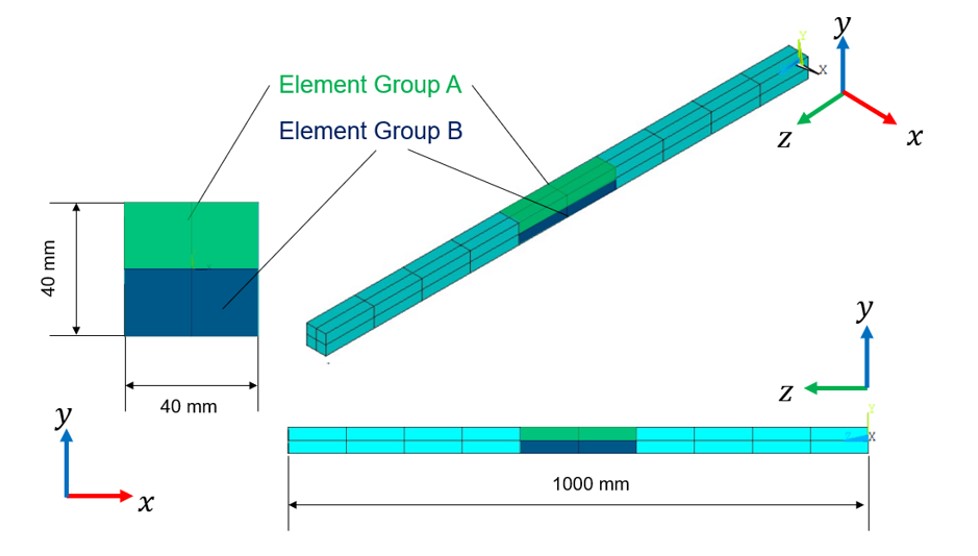Nondestructive Evaluation of Three-Dimensional Plastic Strains Based on Nonlinear Inverse Analysis Using Displacements
Main Article Content
Abstract
In order to achieve a rapid supply of electricity from power plants after an earthquake, the integrity of power plants needs to be assessed more quickly and accurately. Currently, hardness tests are used as a method to evaluate the plastic strain of pipes after a relatively large earthquake, but only the outer surface of the pipes can be measured. Furthermore, it cannot be regarded as a non-destructive test, as the hardness test produces indentations. There is a method to estimate the three-dimensional plastic strain, which is the cause of the displacement, from the non-destructively measured surface displacement by inverse problem analysis. The aim of this study is to apply this method to the non-destructive estimation of plastic strains for whole structure using displacements caused by external forces, and to verify its effectiveness by numerical analysis. Here, the relationship between plastic strains and displacements becomes non-linear when relatively large plastic strain is generated. In order to solve such a non-linear problem, an inverse analysis method using iterative calculations was introduced. In order to verify the principle of the method, a simple three-point bending model is used in this numerical analysis and its plastic strains are estimated using the surface displacements. The numerical results show that the plastic strain distribution can be estimated with relatively high accuracy for large deformation where the relation between plastic strains and displacements becomes non-linear.
Article Details

This work is licensed under a Creative Commons Attribution-NonCommercial-ShareAlike 4.0 International License.
This work is licensed under a Creative Commons Attribution-NonCommercial-ShareAlike 4.0 International License.
References
JANTI SANE Committee. Guideline for structural integrity assessment for nuclear power components subjected seismic load [Internet]. 2012 [cited 2023 Sep 22]. Available from: http://www.gengikyo.jp/ archive/pdf/JANTI-SANE-G1.pdf
Kim JS, Kim JY. An efficient simplified elastic–plastic analysis procedure using engineering formulae for strain-based fatigue assessment of nuclear safety class 1 piping system subjected to severe seismic loads. Int J Fatigue. 2021;151:106390.
Tiryakioğlu M, Robinson JS. On the representative strain in Vickers hardness testing of 7010 aluminum alloy. Mate Sci Eng A. 2015;641:231-236.
Yang XJ, Wang L. A modified Tikhonov regularization method. J Comput Appl Math. 2015;288:180-192.
Kubo S. Inverse problems. Tokyo: Baifukan; 1992.
Mura T. General theory of eigenstrains. In: Mura T, editor. Mechanics of Elastic and Inelastic Solids. Dordrecht: Springer; 1987. p. 1-73.
Korsunsky AM. A teaching essay on residual stresses and eigenstrains. Oxford: Butterworth-Heinemann; 2017.
Uzun F, Korsunsky AM. On the analysis of post weld heat treatment residual stress relaxation in Inconel alloy 740H by combining the principles of artificial intelligence with the eigenstrain theory. Mater Sci Eng A. 2019;752:180-191.
Ogawa M, Inohara T, Nakamura H. Simultaneous non-destructive estimation method of welding deformations and three-dimensional residual stresses by using surface displacements and surface elastic strains. Transactions of the JSME. 2023;89(924):1-13. (In Japanese)
Masuda K, Nakamura H. Improvement of the inverse analysis approaches for assessment of welding deformations and residual stresses by using thermo elasto-plastic welding simulation: (1st report, stress analysis for the bead flush method). Transactions of the Japan Society of Mechanical Engineers Series A. 2010;76(767):884-892. (In Japanese)
Masuda K, Nakamura H. Improvement of the inverse analysis approaches for assessment of welding deformations and residual stresses by using thermo elasto-plastic welding simulation (2nd report, deformation analysis). Transactions of the Japan Society of Mechanical Engineers Series A. 2010;76(769):1186-1194. (In Japanese)
Terasaki T. Weld distortion and residual stress. Journal of the Japan Welding Society. 2009;78(2):139-146. (In Japanese)
Hatano K, Nakamura H, Sakaguchi M, Ogawa M, Inohara T, inventors. A method and devices for estimating strain distribution in mechanical parts. Japan: Japanese Patent no. 6958839. 2021.
Ogawa M, Inohara T, Hatano K, Nakamura H. Proposal of a non-destructive evaluation method of inelastic strain based on the eigen-strain theory for turbine blades. The 24th Kanto Branch Conference of the Japan Society of Mechanical Engineers; 2018 Mar 3; Tokyo, Japan. p. 1-5. (In Japanese)
Fujii S, Ogawa M, Hirabayashi D. Non-destructive estimation of three-dimensional inelastic strain via nonlinear inverse analysis using displacement. Mech Eng J. 2023;10(4):1-12.
Moore EH. General analysis. USA: American Philosophical Society; 1935.
McMeeking RM, Rice JR. Finite-element formulations for problems of large elastic deformation. Int J Solids Struct. 1975;11(5):601-616.
Lu H, Cary PD. Deformation measurements by digital image correlation: implementation of a second-order displacement gradient. Experimental Mechanics. 2000;40(4):393-400.



